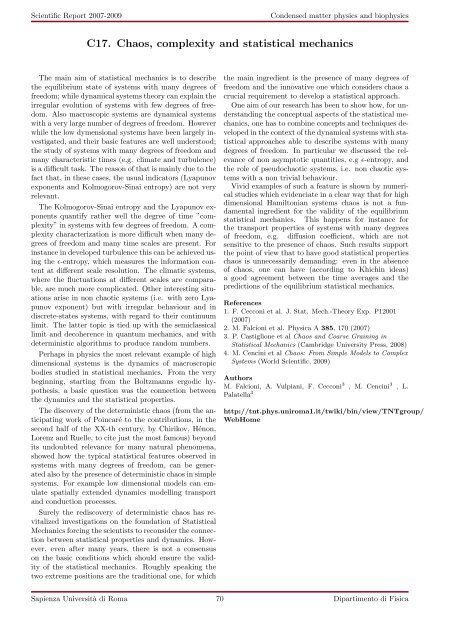download report - Sapienza
download report - Sapienza
download report - Sapienza
You also want an ePaper? Increase the reach of your titles
YUMPU automatically turns print PDFs into web optimized ePapers that Google loves.
Scientific Report 2007-2009<br />
Condensed matter physics and biophysics<br />
C17. Chaos, complexity and statistical mechanics<br />
The main aim of statistical mechanics is to describe<br />
the equilibrium state of systems with many degrees of<br />
freedom; while dynamical systems theory can explain the<br />
irregular evolution of systems with few degrees of freedom.<br />
Also macroscopic systems are dynamical systems<br />
with a very large number of degrees of freedom. However<br />
while the low dymensional systems have been largely investigated,<br />
and their basic features are well understood;<br />
the study of systems with many degrees of freedom and<br />
many characteristic times (e.g. climate and turbulence)<br />
is a difficult task. The reason of that is mainly due to the<br />
fact that, in these cases, the usual indicators (Lyapunov<br />
exponents and Kolmogorov-Sinai entropy) are not very<br />
relevant.<br />
The Kolmogorov-Sinai entropy and the Lyapunov exponents<br />
quantify rather well the degree of time ”complexity”<br />
in systems with few degrees of freedom. A complexity<br />
characterization is more difficult when many degrees<br />
of freedom and many time scales are present. For<br />
instance in developed turbulence this can be achieved using<br />
the ϵ-entropy, which measures the information content<br />
at different scale resolution. The climatic systems,<br />
where the fluctuations at different scales are comparable,<br />
are much more complicated. Other interesting situations<br />
arise in non chaotic systems (i.e. with zero Lyapunov<br />
exponent) but with irregular behaviour and in<br />
discrete-states systems, with regard to their continuum<br />
limit. The latter topic is tied up with the semiclassical<br />
limit and decoherence in quantum mechanics, and with<br />
deterministic algorithms to produce random numbers.<br />
Perhaps in physics the most relevant example of high<br />
dimensional systems is the dynamics of macroscropic<br />
bodies studied in statistical mechanics. From the very<br />
beginning, starting from the Boltzmanns ergodic hypothesis,<br />
a basic question was the connection between<br />
the dynamics and the statistical properties.<br />
The discovery of the deterministic chaos (from the anticipating<br />
work of Poincaré to the contributions, in the<br />
second half of the XX-th century, by Chirikov, Hénon,<br />
Lorenz and Ruelle, to cite just the most famous) beyond<br />
its undoubted relevance for many natural phenomena,<br />
showed how the typical statistical features observed in<br />
systems with many degrees of freedom, can be generated<br />
also by the presence of deterministic chaos in simple<br />
systems. For example low dimensional models can emulate<br />
spatially extended dynamics modelling transport<br />
and conduction processes.<br />
Surely the rediscovery of deterministic chaos has revitalized<br />
investigations on the foundation of Statistical<br />
Mechanics forcing the scientists to reconsider the connection<br />
between statistical properties and dynamics. However,<br />
even after many years, there is not a consensus<br />
on the basic conditions which should ensure the validity<br />
of the statistical mechanics. Roughly speaking the<br />
two extreme positions are the traditional one, for which<br />
the main ingredient is the presence of many degrees of<br />
freedom and the innovative one which considers chaos a<br />
crucial requirement to develop a statistical approach.<br />
One aim of our research has been to show how, for understanding<br />
the conceptual aspects of the statistical mechanics,<br />
one has to combine concepts and techniques developed<br />
in the context of the dynamical systems with statistical<br />
approaches able to describe systems with many<br />
degrees of freedom. In particular we discussed the relevance<br />
of non asymptotic quantities, e.g ϵ-entropy, and<br />
the role of pseudochaotic systems, i.e. non chaotic systems<br />
with a non trivial behaviour.<br />
Vivid examples of such a feature is shown by numerical<br />
studies which evidenciate in a clear way that for high<br />
dimensional Hamiltonian systems chaos is not a fundamental<br />
ingredient for the validity of the equilibrium<br />
statistical mechanics. This happens for instance for<br />
the transport properties of systems with many degrees<br />
of freedom, e.g. diffusion coefficient, which are not<br />
sensitive to the presence of chaos. Such results support<br />
the point of view that to have good statistical properties<br />
chaos is unnecessarily demanding: even in the absence<br />
of chaos, one can have (according to Khichin ideas)<br />
a good agreement between the time averages and the<br />
predictions of the equilibrium statistical mechanics.<br />
References<br />
1. F. Cecconi et al. J. Stat. Mech.-Theory Exp. P12001<br />
(2007)<br />
2. M. Falcioni et al. Physica A 385, 170 (2007)<br />
3. P. Castiglione et al Chaos and Coarse Graining in<br />
Statistical Mechanics (Cambridge University Press, 2008)<br />
4. M. Cencini et al Chaos: From Simple Models to Complex<br />
Systems (World Scientific, 2009)<br />
Authors<br />
M. Falcioni, A. Vulpiani, F. Cecconi 3 , M. Cencini 3 , L.<br />
Palatella 3<br />
http://tnt.phys.uniroma1.it/twiki/bin/view/TNTgroup/<br />
WebHome<br />
<strong>Sapienza</strong> Università di Roma 70 Dipartimento di Fisica

















